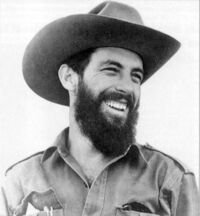More languages
More actions
Camilo Cienfuegos | |
|---|---|
 | |
| Born | 6 February 1932 Havana, Cuba |
| Died | 28 October 1959 Straits of Florida |
| Cause of death | Disappeared |
| Nationality | Cuban |
| Political orientation | Anti-imperialism Anti-colonialism |
Camilo Cienfuegos Gorriarán (February 6, 1932 – October 28, 1959) was a Cuban revolutionary. Along with Fidel Castro, Raúl Castro, Che Guevara and Juan Almeida Bosque, he was a member of the 26th of July Movement, which overthrew Cuba's fascist Statesian-backed dictator, Fulgencio Batista. Cienfuegos became one of Castro's top guerrilla commanders during the Cuban Revolution, and later served as head of the Cuban Armed Forces under Fidel Castro's socialist government. He led agrarian reform but disappeared shortly after the revolution, probably in a plane crash.[1]
Life[edit | edit source]
Early Life[edit | edit source]
Cienfuegos was born in Lawton, Havana in 1932.[2]
He enrolled initially at the public school, San Francisco de Paula elementary. He then enrolled in San Alejandro National Academy of Fine Arts but left because of financial problems. He followed his father's footsteps into becoming a tailor.[1][2]
Pre-Revolution[edit | edit source]
In 1948, Cienfuegos protested against Havana raising bus fares. He began fighting the Batista regime in 1952. In 1953, he went to the United States with Rafael Sierra and joined Cuban Civic Action, a leftist organization of Cuban exiles. He protested against US-backed dictators like Batista, Trujillo, and Somoza. Immigration officials arrested him and Sierra in San Francisco and sent them to Mexico.[1][2]
Cienfuegos and Rafael Sierra stayed in New York. They fled New York for Chicago after violence erupted in New York. They then traveled to San Francisco. He was deported from the USA and sent back to Cuba.[1][2]
In Cuba, he was injured at a protest and was arrested. After being arrested he was tortured and sent into exile again. He was sent to New York again after that. He traveled to Mexico after learning about Fidel Castro's 26th of July Movement.[1][2]
Revolutionary Activities[edit | edit source]
Cienfuegos met with Castro in Mexico in May of 1956.[1]
He arrived, along with the other revolutionaries, in Cuba on the Granma yacht expedition. He joined the Jose Marti Column during the revolution.[2]
In 1957, Cienfuegos became a lieutenant. Then, in 1958, he was promoted to Commander and Chief of the Antonio Maceo Column. He lead military actions in Bayamo, Las Tunas, and Manzanillo. He also was instrumental in the civil war expanding into western Cuba. He lead the revolutionary forces in the successful Battle of Yaguajay.[1][2]
Post-Revolution[edit | edit source]
After the end of the revolution, Cienfuegos became the Chief of the Revolutionary Army and took over the former headquarters of Batista's army, the Columbia Camp.[2]
He disappeared while traveling from Camaguey to Havana in a plane on Oct. 28, 1959. His remains were never recovered despite extensive search efforts.[2]
References[edit | edit source]
- ↑ 1.0 1.1 1.2 1.3 1.4 1.5 1.6 Devin Cole (2022-02-07). "Camilo Cienfuegos: Celebrating the young revolutionary" Workers World. Archived from the original on 2023-02-07.
- ↑ 2.0 2.1 2.2 2.3 2.4 2.5 2.6 2.7 2.8 "Cubans Remember 91st Birth Anniversary Of Camilo Cienfuegos" (2023-02-06). teleSUR. Retrieved 2023-07-15.
